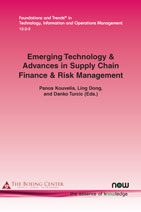Disruption Risk Management in Serial Multi-Echelon Supply Chains
By Florian Lücker, Cass Business School, City University of London, UK, florian.lucker@city.ac.uk | Sunil Chopra, Northwestern University, USA, s-chopra@kellogg.northwestern.edu | Ralf W. Seifert, EPFL and IMD, Switzerland, ralf.seifert@epfl.ch
Abstract
This research focuses on managing supply chain disruption risk using inventory and reserve capacity in serial multi-echelon supply chains. The research problem is to determine the optimal risk mitigation inventories and reserve capacities when product transformation occurs at each echelon. Disruptions at each echelon are modeled as a random process. We derive insights on the optimal location and quantity of risk mitigation inventory (RMI) and reserve capacity held in serial supply chains. We show that the downstream echelon typically holds at least as much RMI as the upstream echelon. At the same time, it is often optimal to hold additionally more reserve capacity downstream than upstream. These results hold under the assumption that inventory and reserve capacity holding costs are larger downstream than upstream. Our research also suggests that RMI is preferred to reserve capacity as a risk mitigation lever in long serial supply chains, i.e., in supply chains with a large number of echelons. This research problem is inspired by a risk management problem of a leading pharmaceutical company.
Emerging Technology & Advances in Supply Chain Finance & Risk Management
Emerging Technology & Advances in Supply Chain Finance & Risk Management reflects the state-of-the-art in research thought leadership in supply chain finance and risk management, and it contains great expository pieces on how advanced technologies are shaping supply chains and risk management within them. You will also find ideas on how supply chain finance and risk management can be best taught in our classrooms.
The volume is divided into three parts, each part reflecting a major active research area of the field including: Part 1: Supply Chain Finance; Part 2: Financial Hedging and Commodity Risks; Part 3: Operational Strategies and Risk Management.
Part 1 deals with the broad area of supply chain finance and programs that will better allow for working capital management within supply chains. Part 2 introduces concepts of hedging financial and operational risks due to uncertain commodity prices, fluctuating exchange rates, and volatile interest rates. Emphasis is placed on understanding how financial hedges can be used for hedging relevant supply chain risks in a way that reflects modern view of financial risk management. Part 3 examines topics and solution approaches reflecting the more traditional treatments in the contemporary literature of operational and supply chain risks. This volume provides rich implications for future research directions in efforts to master the new complexities and uncertainties of the global business environment and better understand the impact of advanced technologies in global supply chains.

Companion
Foundations and Trends® in Technology, Information and Operations Management, Volume 12, Issue 2-3 Special Issue: Emerging Technology & Advances in Supply Chain Finance & Risk Management
See the other articles that are also part of this special issue.